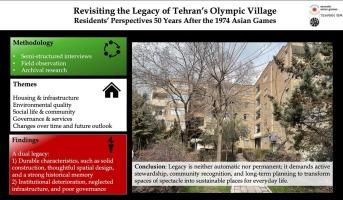Revisiting the legacy of Tehran's Olympic Village: Residents' perspectives 50 years after the 1974 Asian Games
IF 6.6
1区 经济学
Q1 URBAN STUDIES
引用次数: 0
Abstract
The 1974 Asian Games marked Iran's first and only experience hosting a sporting mega-event. This paper revisits the legacy of its primary residential site, Tehran's Olympic Village, fifty years later by examining current residents' perspectives on the neighborhood. The goal is to understand how residents today evaluate and make sense of the Village in their everyday lives, offering insight into the lived legacy of this former spectacle space. The primary method involved semi-structured interviews with fifteen residents, triangulated with multi-phase field observations and extensive document analysis. Interviews were coded through the lens of Olympic Villages typological framework and analyzed thematically. The discussion draws on Post-Occupancy Evaluation as an interpretive lens to assess how long-term resident experience reflects changes in built form, environmental quality, social life, governance and services, and the neighborhood changes and meaning. Findings reveal a dual legacy: while the Village still benefits from durable construction, thoughtful spatial design, and a strong historical memory, residents face challenges including deteriorating infrastructure, weakening neighborhood identity, and declining local governance. The area's layout and natural setting remain notable assets, but its distinctiveness is increasingly fragile due to later developments and municipal disengagement. As a case that spans pre- and post-revolutionary urban development in Tehran, the Village reflects how mega-event spaces can drift from their original purpose when not actively maintained. Ultimately, the study argues that urban legacy is not self-sustaining. It requires active stewardship, community recognition, and sustained planning to transform spaces of spectacle into lasting places for everyday life.

回顾德黑兰奥运村的遗产:1974年亚运会50年后居民的视角
1974年的亚运会是伊朗第一次也是唯一一次举办大型体育赛事的经历。本文通过考察当前居民对该社区的看法,重新审视了其主要居住区——德黑兰奥运村50年后的遗产。目的是了解今天的居民如何在他们的日常生活中评估和理解这个村庄,并深入了解这个前景观空间的生活遗产。主要方法包括与15名居民进行半结构化访谈,采用多阶段实地观察和广泛的文件分析进行三角测量。访谈通过奥运村类型学框架进行编码,并进行主题分析。讨论将使用后评估作为一种解释视角,以评估长期居民体验如何反映建筑形式、环境质量、社会生活、治理和服务以及社区变化和意义的变化。研究结果揭示了双重遗产:虽然该村仍然受益于耐用的建筑,周到的空间设计和强烈的历史记忆,但居民面临着包括基础设施恶化,社区认同感减弱和地方治理下降在内的挑战。该地区的布局和自然环境仍然是值得注意的资产,但由于后来的发展和市政脱离,其独特性越来越脆弱。作为一个跨越德黑兰革命前和革命后城市发展的案例,该村反映了大型活动空间在没有积极维护的情况下如何偏离其最初的目的。最后,该研究认为,城市遗产并不能自我维持。它需要积极的管理、社区认可和持续的规划,将景观空间转变为日常生活的持久场所。
本文章由计算机程序翻译,如有差异,请以英文原文为准。
求助全文
约1分钟内获得全文
求助全文
来源期刊

Cities
URBAN STUDIES-
CiteScore
11.20
自引率
9.00%
发文量
517
期刊介绍:
Cities offers a comprehensive range of articles on all aspects of urban policy. It provides an international and interdisciplinary platform for the exchange of ideas and information between urban planners and policy makers from national and local government, non-government organizations, academia and consultancy. The primary aims of the journal are to analyse and assess past and present urban development and management as a reflection of effective, ineffective and non-existent planning policies; and the promotion of the implementation of appropriate urban policies in both the developed and the developing world.
 求助内容:
求助内容: 应助结果提醒方式:
应助结果提醒方式:


